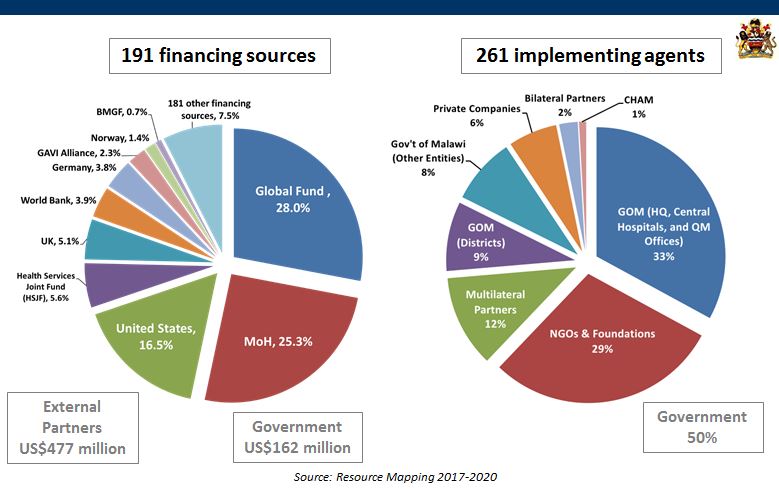Malawi’s health sector programs are financed and implemented by hundreds of organizations. In the past, the Ministry of Health and Population (MOHP) has found it challenging to track and coordinate the activities of all partners. To address this challenge, and in the spirit of promoting transparency and aid effectiveness, the MOH, through the DPPD, has adopted and institutionalized an annual Resource Mapping (RM) exercise.
Resource mapping tracks the budgets and expenditures of all health sector organizations, thereby providing valuable information for the national annual budgeting process. It enables organizations to make evidence-based decisions in order to inform their budgeting process and yearly operational plans, as well as improve resource allocation, coordination with other stakeholders, and harmonization with MOHP priorities. The first round of the RM exercise began in January 2012 and has continued annually through the fifth round of the RM exercise, which is presented in this report. For a quick overview of the key points, please refer to the summary below:
KEY QUESTIONS
Who is providing resources for health programs and who is implementing them?
What are available funds being spent on or budgeted for?
Where are the resources being spent or budgeted for?
KEY FINDINGS
Financial Resources:
Health sector resources were estimated at $639 million for FY 2017/18. This remains roughly constant from previous years.
Between FY 2017/18 and FY 2019/20, a total of US$1.8 billion is projected to flow into Malawi’s health sector.
While the total resource envelope has grown by US$32 million from FY2015/16, allocation to the health sector as a percentage of projected GDP has dropped from 11% to 9.5% over this period.
Donor Funding:
In 2017/18, 75% of the health sector is donor-funded – among the highest in the world – and Government funding accounts for only 25% of total funds.
The top 9 donors contribute 90% of the external funding.
One out of every four dollars for health comes from the Global Fund.
Resource Allocation:
Programmatic areas
While 64% of the GoM’s health budgets contribute to HSS, only 28% of partner funding contributes to HSS objectives.
Among HSSP-II Objectives, Service Delivery, HRH and Infrastructure and Medical Equipment receive the highest share of the resources.
The objectives of HRH and Infrastructure and Medical Equipment receive the highest government contribution as a % of total funding.
Among programmatic areas, HIV/AIDS receives the largest portion of funding (31%), followed by RMNCH (8%) and Malaria (7%).
All disease areas except NTDs, Respiratory Infections, Mental Health and NCDs are over 90% donor-funded.
- Geographic distribution
US$388 million (61%) of the resource envelope was earmarked for districts. Total funding per district ranges from US$5 million (Likoma) to US$44 million (Lilongwe).
85% or more of the budget of Phalombe, Rumphi, Ntchisi, and Blantyre is funded by external Partners.
- Fragmentation:
- There are 191 financing sources and 261 implementing partners in Malawi’s health sector.
- Two-thirds of implementers have annual budgets under US$500,000.
- As an implementing agent, GoM accounts for 50% of the total resources in the health sector.
MAIN CONCLUSIONS
Most financing comes from external sources and is highly fragmented
Almost all HSSP II objectives are primarily funded by donors, thus aid coordination will be essential for a successful HSSP II.


